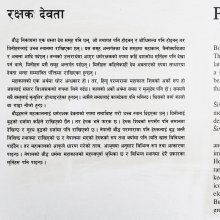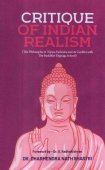Darkness: 2 definitions
Introduction:
Darkness means something in Hinduism, Sanskrit. If you want to know the exact meaning, history, etymology or English translation of this term then check out the descriptions on this page. Add your comment or reference to a book if you want to contribute to this summary article.
Images (photo gallery)
In Hinduism
Shilpashastra (iconography)
Source: Shodhganga: Elements of Art and Architecture in the Trtiyakhanda of the Visnudharmottarapurana (shilpa)The Darkness (of night) follows specific guidelines of ancient Indian Painting (citra), according to the Viṣṇudharmottarapurāṇa, an ancient Sanskrit text which (being encyclopedic in nature) deals with a variety of cultural topics such as arts, architecture, music, grammar and astronomy.—In the Viṣṇudharmottarapurāṇa, some natural phenomena are referred to be portrayed with the help of symbolization in a picture. According to the Viṣṇudharmottarapurāṇa darkness of night should be shown with the picture of men approaching their abodes. In the Meghadūta, Kālidāsa projected the scene of night with a path, persuaded by some love affected women.

Shilpashastra (शिल्पशास्त्र, śilpaśāstra) represents the ancient Indian science (shastra) of creative arts (shilpa) such as sculpture, iconography and painting. Closely related to Vastushastra (architecture), they often share the same literature.
Yoga (school of philosophy)
Source: ORA: Amanaska (king of all yogas): A Critical Edition and Annotated Translation by Jason BirchThe Darkness (of many conflicting opinions) is denoted by the Sanskrit term Dhvānta, according to the Haṭhapradīpikā of Svātmārāma: an influential 15th-century Sanskrit manual on Hatha-Yoga dealing with techniques to channel one’s vital energy.—Accordingly, “The compassionate Svātmārāma presents the Haṭhapradīpikā for those ignorant of Rājayoga because of their confusion in the darkness (dhvānta) of many [conflicting] opinions”.

Yoga is originally considered a branch of Hindu philosophy (astika), but both ancient and modern Yoga combine the physical, mental and spiritual. Yoga teaches various physical techniques also known as āsanas (postures), used for various purposes (eg., meditation, contemplation, relaxation).
See also (Relevant definitions)
Ends with: Outer Darkness.
Full-text (+1218): Andhakara, Tamas, Timira, Dhvanta, Tama, Tamomaya, Tamisra, Avatamasa, Tamoguna, Tamasa, Ghanatimira, Andhatamasa, Andhatamisra, Viyadbhuti, Niranjana, Mecaka, Andha, Ratri, Sharvara, Vitamas.
Relevant text
Search found 362 books and stories containing Darkness; (plurals include: Darknesses). You can also click to the full overview containing English textual excerpts. Below are direct links for the most relevant articles:
Maha Prajnaparamita Sastra (by Gelongma Karma Migme Chödrön)
Appendix 2 - Lokāntarikā (intermediate spaces between two worlds) < [Chapter XLVII - Praises made by the Buddhas]
Part 4 - Illuminating the darkness of the intermediary worlds < [Chapter LI - Seeing all the Buddha Fields]
Part 2 - The true nature of dharmas < [Chapter XXIX - The Virtue of Wisdom]
Relationship < [July – September, 1981]
Realising the Language of Darkness < [July – September, 2001]
Night < [Jan-Feb 1940]
The Markandeya Purana (by Frederick Eden Pargiter)
The Great Chariot (by Longchenpa)
Part 5 - The examples of naturelessness < [B. The view that realizes suchness]
Part 5 - The instruction to attend on good friends < [D. Beings to be avoided, along with those associated with them]
3c) The animal realm < [Part 3 - The main divisions]
Vakyapadiya of Bhartrihari (by K. A. Subramania Iyer)
Verse 3.14.399 < [Book 3 - Pada-kāṇḍa (14): Vṛtti-samuddeśa (On Ccomplex Formation)]
Verse 3.14.381 < [Book 3 - Pada-kāṇḍa (14): Vṛtti-samuddeśa (On Ccomplex Formation)]
Verse 3.14.404-405 < [Book 3 - Pada-kāṇḍa (14): Vṛtti-samuddeśa (On Ccomplex Formation)]
Narayaniya (Narayaneeyam) (by Vishwa Adluri)
Related products





